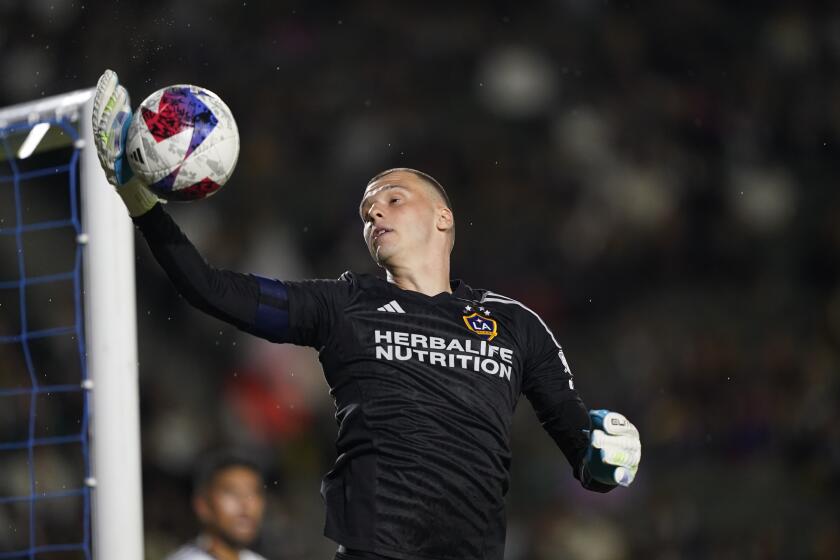Top Farrier: He Stoops to Conquer : Feisty Del Mar Shoer Keeps Thoroughbreds on Solid Footing
Jack Anderson (Buzz) Fermin is in his usual position: Wrestling with a powerful, cantankerous and uncooperative filly in the Del Mar stable area, laboring to get her hoof in position so he can shoe her.
“She wants to kick me, she wants to kick me, dammit! I can see it in her eyes,” the earthy-mouthed, rough-hewn Fermin declares, unleashing a characteristic string of invective at the beast before finally nudging the foot into correct position. “You get tough in this business. You’re going to get hit, get kicked, get stepped on, break a few bones, and you’re going to get criticized. You’ve got to be pretty thick-skinned. And you’ve got to know what the hell you’re doing.”
Fermin knows what he’s doing. One of about 40 farriers, or horseshoers, who work the horses that run at Del Mar Race Track, Buzz, as he is widely known, has contracts with four of the track’s top trainers and is considered one of the best shoers on the Southern California racing circuit.
Job Is Critical
His labors are rarely contemplated by the thousands of bettors who go daily to the track, yet he performs a critical role. For, without proper shoe and hoof care, a horse that may have cost millions is not going to be a winner, and may end up lame.
“With no foot, you got no horse,” says trainer Gary Jones, whose horses are shoed by Fermin.
Fermin, at 52 one of the senior shoers, is also very much a product of the racing industry: His father, Armando Fermin, was a well-known and sometimes controversial Cuban-born jockey. (“I know he was shot at a few times,” his son acknowledged with a laugh.)
Buzz, who grew up around San Ysidro and spent considerable time at the Agua Caliente Racetrack in Tijuana, has worked his entire life in the insular world of racing’s backstretch, as the stable area is known. He shoveled hay, groomed horses and performed sundry other tasks before becoming a shoer at the relatively late age of 32.
“I noticed that the only people driving new cars around the track were the horseshoers,” says Fermin, explaining his decision to learn the trade. “I had a family, and I had to feed them.”
He has certainly prospered, having worked throughout the nation and earning enough to purchase homes in Del Mar and Monrovia for himself, his three children and his wife, Ingrid, a state racing steward. “I got into this business to make money,” acknowledged Fermin, who says a good shoer should earn “at least” $100,000 a year, “and I’ve made a lot of it.”
But Fermin has also paid the price: He is a recovering alcoholic and cocaine addict, his problems mirroring those encountered by untold other employees of the insular stable area, where monotony, long hours and the lure of quick money combine to wreak havoc on many lives. “A lot of guys get hung up here, and are never exposed to the real world,” explained Alex Trujillo, a counselor with the Winners Foundation, a service for drug and alcohol abusers that works with the track staff.
Buzz says he has been clean for 4 1/2 years, but he takes nothing for granted, attending Alcoholics Anonymous meetings several times a week, always encouraging younger track workers to come along. “One day at a time,” says the bumper sticker on his trademark-black, 1984 El Camino.
“I feel like a million dollars since I sobered up,” says Buzz, a firmly built man with close-cropped hair, a deep-lined face and horse tattoos on his forearms. “It used to be that I’d hang around the track till late, drinking beer, waiting for my connection. My life was in such a state of turmoil, I thank God I’m alive. . . . I look back at it all now, and I say, ‘What a fool I was.’ ”
The horseshoer’s day at Del Mar and other tracks begins early. Horses need new shoes about every three weeks. Farriers are also frequently called upon to check for damaged shoes and hoofs.
By 7 a.m., Fermin’s car, filled with horseshoeing equipment, is bouncing through Del Mar’s dusty backstretch, as grooms bathe the thoroughbreds, hot-walkers exercise the horses and veterinarians monitor their health. Buzz wears a white T-shirt, socks and sneakers, his chaps covering his white shorts. He totes a heavy metal tool case from the back of his El Camino to each stable.
He Has the Touch
“Everything this man touches turns to gold,” says Rudolph Roberts, a longtime groom who has a running repartee with the blacksmith. “The problem is, he ain’t got no class.”
From his car, a smiling Fermin fires back a bawdy string of epithets. It is a ritual that will be repeated many times as the day wears on. Fermin will also curse the horse-racing profession many times--”There’s no damn integrity in this business”--but it is also clear that the bluster masks a real affection for the industry.
“The people here are fantastic,” Buzz confesses, although he acknowledges not encouraging any of his children to become involved. “I don’t know what else I could have done with myself. I like the hours, I like working outside, and I like the money.”
Soon, Fermin is in his familiar position, bent over, nails in his mouth, hammer or file in his hand, shoeing horses and spewing verbal abuse at horses and people alike. He earns about $75 a horse, he says, often shoeing 10 or more a day.
“I’m always looking for problems in the foot, for bruises, whatever,” says Buzz as he digs out dirt, manure and other material packed in the hoof of a colt called Candlelight Song, which was scheduled to race that day. Early discovery of a bruise can save a horse’s career.
Shoeing is a laborious, multistep process: The old shoes are removed, dirt is cleaned out, hoofs are trimmed, new shoes are shaped and nailed in, and the foot is evened out and filed. Each horse takes Fermin 20-25 minutes.
“You can’t rush it,” he says, taking a break in the shade of the stable corridor, sweat beading on his brow. “And you’ve got to treat one horse the same as the next. I didn’t get to where I was by giving one horse preferential treatment.”
Indeed, on this day, Fermin puts new shoes on Ferdinand, a $20-million former Kentucky Derby winner. There is little variance in his shoeing technique, or in the barrage of curses he directs at the high-priced, chestnut stallion, clearly not happy with the prospect of new shoes. The shoer admires horses that are “gutsy”--that run with pain, and give their all--but, gutsy or not, the animals don’t necessarily like the blacksmith’s presence.
“I probably get kicked every day,” says Fermin, whose work prevents him from wearing a cast on his left hand to heal the bone broken by a horse kick. “But you got to realize that there’s a technique to getting kicked, too. You want to be close to the horse, so he doesn’t get you with his full power.”
As Fermin works, nearby colleagues routinely aim barbs his way. “Usually, when Buzz is done with a horse,” says Donn Luby, a trainer, “the animal limps away.”
Fermin also dishes it out non-stop, lambasting trainers, grooms, walkers and just about anyone else. “Has it ever occurred to the trainer that the horse may be sore because he’s overworked?” he wonders facetiously, after he is asked to look at a horse with a bad foot.
“Buzz may be the best blacksmith in America,” says Gary Jones, a trainer whose father, Farrell, helped give Fermin his start in the shoeing business, “but he has been known to make mistakes.”
For instance, there was the time two of Buzz’s horses lost their shoes during a race at Bay Meadows in San Mateo. “The mud was real thick,” Buzz says in his defense.
Then there was the time that Buzz got his hands stuck together while using a new compound for repairing cracked hoofs. He had to have the skin removed surgically at the hospital, although he says he was back at the track the next day.
Once an avid bettor, Fermin says he seldom plays the horses these days, although other stable-area employees spend much of their free time reviewing programs and analyzing the day’s card. “You think you know something because you’re around all these horses,” he says, “then you go out and lose all your money.”
The day’s work done, Buzz packs his tools back into his El Camino, fires off a few more verbal volleys, and drives out of the stable areas. “Getting too old for this kind of work,” he says, muttering some lines about retirement.
More to Read
Get our high school sports newsletter
Prep Rally is devoted to the SoCal high school sports experience, bringing you scores, stories and a behind-the-scenes look at what makes prep sports so popular.
You may occasionally receive promotional content from the Los Angeles Times.






